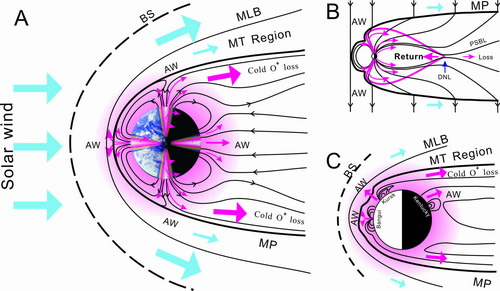|
Ionosphere and Upper Atmospheric Physics
|
Oxygen escape linked to geomagnetic reversals and mass extinction
In the past half century, many efforts have been devoted to understanding the links between geomagnetic reversals and mass extinctions, but no consensus has been reached. The newest databases available for the Phanerozoic era illustrate that when the marine diversity showed a gradual pattern of mass extinctions lasting millions of years the reversal rate increased and the atmospheric oxygen level decreased (Figure 1). An important test of any successful mechanism is to explain the patterns of mass extinctions. Fossil records reveal that a mass extinction has a gradual pattern persisting for millions of years, during which a stepwise pattern is manifested by a series of impulse extinctions. These patterns suggest that the main cause should be continual environmental degradation. The drop of atmospheric O2 level has been verified to be able to induce environmental degradation because reducing the supply of O2 is lethal for most species. However, it is difficult to explain the O2 level drops if only considering Earth-bounded geochemical processes. An alternative possibility is that the O2 molecules are broken into oxygen atoms by solar radiation and subsequently ionized. These O+ ions are further energized in the ionosphere by the solar wind forcing and can thus overcome containment by the magnetosphere and gravity and can escape into interplanetary space.
Prof. WEI Yong with his co-authors hypothesized that geomagnetic reversals cause O2 level drops and the subsequent mass extinctions, since the magnetospheric containment of oxygen is expected to be severely weakened when the dipole collapses during geomagnetic reversals. They speculated that accumulated oxygen escape during an interval of increased reversal rate could have led to the catastrophic drop of oxygen level, which is known to be a cause of mass extinctions. To test this new hypothesis, they simulated the oxygen ion escape rate for the Triassic–Jurassic event, using a modified Martian ion escape model (Figure 2) with an input of quiet solar wind inferred from Sun-like stars. The results indicate that a geomagnetic reversal could enhance oxygen escape rate by 3 - 4 orders of magnitude if the magnetic field was extremely weak, even without consideration of space weather effects. This suggests that the hypothesis could be a possible explanation of the newest data. Therefore, if the causal relation between geomagnetic reversal and mass extinction indeed exists, it should be a "many-to-one" scenario rather the previously thought “one-to-one”, and planetary magnetic fields could be much more important than previously thought for planetary habitability.
Figure 1. Temporal evolution of reversal rate, O2 level and marine diversity over the Phanerozoic era.
Figure 2. Ion escape scenarios for the reversing field, present field and no field of Earth. (A) Mars-like ion escape in a quadrupole-dominated magnetosphere for reversing field. (B) Earth-like ion escape for present field. (C) Fully Mars-like ion escape when the geodynamo totally stops.
This paper was published in Earth and Planetary Science Letters(Wei et al. Oxygen escape from the Earth during geomagnetic reversals: implications to mass extinction. Earth and Planetary Science Letters, 2014, 394: 94-98)
|
Head of Group

Prof. Wan WeixingDivision of Geomagnetism and Space Physics Tel:86 010 82998306 Email:wanw@mail.iggcas.ac.cn |
-
SIMSSecondary Ion Mass Spectrometer Laboratory
-
MC-ICPMSMultiple-collector ICPMS Laboratory
-
EM & TEMElectron Microprobe and Transmission Electron Microscope Laboratory
-
SISolid Isotope Laboratory
-
StIStable Isotope Laboratory
-
RMPARock-Mineral Preparation and Analysis
-
AAH40Ar/39Ar & (U-Th)/He Laboratory
-
EMLElectron Microscopy Laboratory
-
USCLUranium Series Chronology Laboratory
-
SASeismic Array Laboratory
-
SEELaboratory of Space Environment Exploration Laboratory
-
PGPaleomagnetism and Geochronology Laboratory
-
BioMNSFrance-China Bio-mineralization and Nano-structure Laboratory



